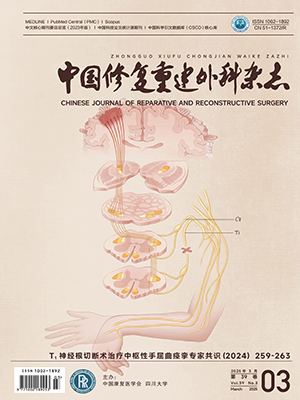Objective To explore the neck axial symptom (AS) after Bryan cervical disc arthroplasty traditional anterior cervical discectomy and fusion, and to make contrastive analysis. Methods From October 2004 to April 2006, 22 patients, 13 males and 9 females, aged 33-54 years old (43.3 on average), underwent Bryan cervical disc placement (group
A). Among them, there were 16 cases of cervical spondylotic myelopathy and 6 of nerve root cervical syndrome, with 20
of single segment replacement and 2 of two segments replacement. The courses of disease were 1-21 months (6 months on average). Meanwhile, 30 patients, 17 males and 13 females, aged 35-64 years old (50.3 on average) underwent traditional anterior cervical discectomy and fusion (group B). Among them, there were 19 cases of cervical spondylotic myelopathy and 11 of nerve root cervical syndrome, with 26 of single segments replacement and 4 of two segments replacement. The course of disease was 1-23 months (7 months on average). In both groups, the neurologic recovery rate, the change of cervical curvature of the operated segments and total range of motion (ROM), and incidence of neck axial symptoms were recorded and compared. Results All the patients were followed up for 24-42 months (30.6 months on average). There was no graveness compl ication happening during and after operation in both groups. There were no compl ications of prosthesis bit shifting and amotio in group A, and group B exhibited a bony fusion on X-ray films 6 months after operation, without plate and bolt loose or broken. The patients’ cl inical symptoms of radiculopathy were obviously rel ieved and the curative effect was satisfactory in two groups of nerve root cervical syndrome. In both groups of cervical spondylotic myelopathy, the patients’ JOA scores at the postoperative follow-up increased obviously than preoperative (P lt; 0.01), and there was no significant difference between the two groups before the operation and at the end of the follow-up (P gt; 0.05). The rate of sagittal al ignment of the operated segment with kyphosis increased obviously in group B, higher than in group A (P lt; 0.05).The total ROM of group B was obviously lower than preoperative (P lt; 0.01), and the pre- and postoperative difference of group A was not statistically significant (P gt; 0.05). The rate of postoperative neck AS was 18.18% in group A and 46.67% in group B, and the difference was statistically significant
(P lt; 0.05). Conclusion Compared with traditional anterior cervical discectomy and fusion, the use of Byran disc arthroplasty for cervical syndrome is associated with good outcomes. At the same time, it can maintain the cervical motion and curvature of operated segments, avoid the decrease of total ROM and lower the incidence of the postoperative neck AS.
Citation: CAO Junming,SHEN Yong,YANG Dalong,DING Wenyuan,MENG Xianzhong,ZHANG Wei,LI Zhiyuan.. CONTRASTIVE ANALYSIS OF NECK AXIAL SYMPTOMS AFTER BRYAN CERVICAL DISC ARTHROPLASTY OR TRADITIONAL ANTERIOR CERVICAL DISCECTOMY AND FUSION/. Chinese Journal of Reparative and Reconstructive Surgery, 2008, 22(10): 1200-1204. doi: Copy
Copyright © the editorial department of Chinese Journal of Reparative and Reconstructive Surgery of West China Medical Publisher. All rights reserved




